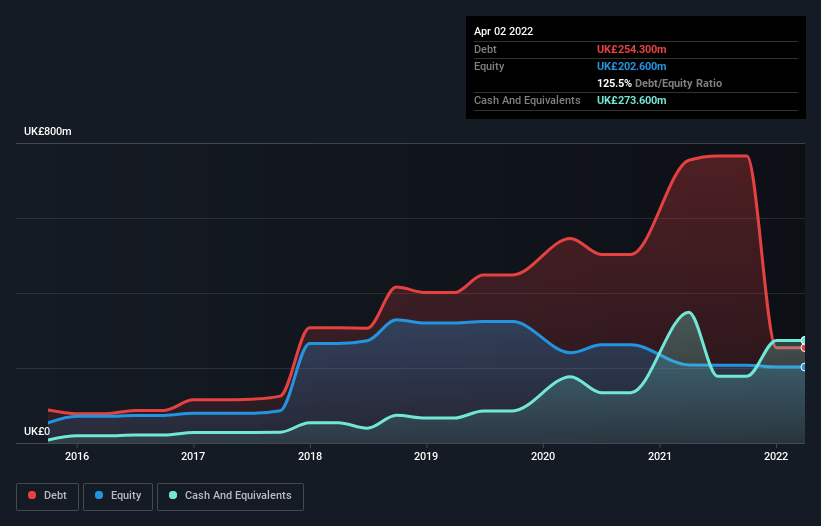- United Kingdom
- /
- Consumer Durables
- /
- AIM:VCP
These 4 Measures Indicate That Victoria (LON:VCP) Is Using Debt Extensively

David Iben put it well when he said, 'Volatility is not a risk we care about. What we care about is avoiding the permanent loss of capital.' It's only natural to consider a company's balance sheet when you examine how risky it is, since debt is often involved when a business collapses. Importantly, Victoria plc (LON:VCP) does carry debt. But is this debt a concern to shareholders?
Why Does Debt Bring Risk?
Generally speaking, debt only becomes a real problem when a company can't easily pay it off, either by raising capital or with its own cash flow. In the worst case scenario, a company can go bankrupt if it cannot pay its creditors. However, a more frequent (but still costly) occurrence is where a company must issue shares at bargain-basement prices, permanently diluting shareholders, just to shore up its balance sheet. Of course, the upside of debt is that it often represents cheap capital, especially when it replaces dilution in a company with the ability to reinvest at high rates of return. The first thing to do when considering how much debt a business uses is to look at its cash and debt together.
Check out our latest analysis for Victoria
What Is Victoria's Net Debt?
You can click the graphic below for the historical numbers, but it shows that Victoria had UK£254.3m of debt in April 2022, down from UK£753.9m, one year before. But on the other hand it also has UK£273.6m in cash, leading to a UK£19.3m net cash position.

How Healthy Is Victoria's Balance Sheet?
We can see from the most recent balance sheet that Victoria had liabilities of UK£380.0m falling due within a year, and liabilities of UK£1.08b due beyond that. Offsetting these obligations, it had cash of UK£273.6m as well as receivables valued at UK£223.8m due within 12 months. So it has liabilities totalling UK£965.4m more than its cash and near-term receivables, combined.
This deficit casts a shadow over the UK£471.6m company, like a colossus towering over mere mortals. So we'd watch its balance sheet closely, without a doubt. After all, Victoria would likely require a major re-capitalisation if it had to pay its creditors today. Given that Victoria has more cash than debt, we're pretty confident it can handle its debt, despite the fact that it has a lot of liabilities in total.
We saw Victoria grow its EBIT by 3.7% in the last twelve months. That's far from incredible but it is a good thing, when it comes to paying off debt. There's no doubt that we learn most about debt from the balance sheet. But ultimately the future profitability of the business will decide if Victoria can strengthen its balance sheet over time. So if you're focused on the future you can check out this free report showing analyst profit forecasts.
But our final consideration is also important, because a company cannot pay debt with paper profits; it needs cold hard cash. While Victoria has net cash on its balance sheet, it's still worth taking a look at its ability to convert earnings before interest and tax (EBIT) to free cash flow, to help us understand how quickly it is building (or eroding) that cash balance. Over the most recent three years, Victoria recorded free cash flow worth 51% of its EBIT, which is around normal, given free cash flow excludes interest and tax. This cold hard cash means it can reduce its debt when it wants to.
Summing Up
While Victoria does have more liabilities than liquid assets, it also has net cash of UK£19.3m. Despite its cash we think that Victoria seems to struggle to handle its total liabilities, so we are wary of the stock. There's no doubt that we learn most about debt from the balance sheet. But ultimately, every company can contain risks that exist outside of the balance sheet. We've identified 2 warning signs with Victoria (at least 1 which can't be ignored) , and understanding them should be part of your investment process.
If, after all that, you're more interested in a fast growing company with a rock-solid balance sheet, then check out our list of net cash growth stocks without delay.
New: Manage All Your Stock Portfolios in One Place
We've created the ultimate portfolio companion for stock investors, and it's free.
• Connect an unlimited number of Portfolios and see your total in one currency
• Be alerted to new Warning Signs or Risks via email or mobile
• Track the Fair Value of your stocks
Have feedback on this article? Concerned about the content? Get in touch with us directly. Alternatively, email editorial-team (at) simplywallst.com.
This article by Simply Wall St is general in nature. We provide commentary based on historical data and analyst forecasts only using an unbiased methodology and our articles are not intended to be financial advice. It does not constitute a recommendation to buy or sell any stock, and does not take account of your objectives, or your financial situation. We aim to bring you long-term focused analysis driven by fundamental data. Note that our analysis may not factor in the latest price-sensitive company announcements or qualitative material. Simply Wall St has no position in any stocks mentioned.
About AIM:VCP
Victoria
Designs, manufactures, and distributes flooring products primarily in the United Kingdom, Italy, Belgium, Spain, Australia, the Netherlands, Turkey, France, Ireland, Portugal, and the United States.
Undervalued slight.
Similar Companies
Market Insights
Community Narratives




